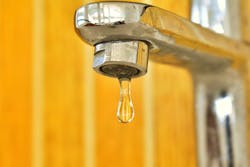EPA announces proposed changes to Lead and Copper Rule
GREEN BAY, WI, OCT 10, 2019 -- Today, the U.S. Environmental Protection Agency (EPA) announced a proposed rule that significantly improves the actions that water systems must take to reduce lead in the nation’s drinking water. EPA Administrator Andrew Wheeler announced the proposal at an event in Green Bay. This action represents the first major overhaul of the Lead and Copper Rule since 1991 and marks a critical step in advancing the Trump Administration’s Federal Action Plan to Reduce Childhood Lead Exposures.
The agency’s proposal takes a proactive and holistic approach to improving the current rule—from testing to treatment to telling the public about the levels and risks of lead in drinking water. When finalized, this proposal will:
- Require more water systems to act sooner to reduce lead levels and protect public health.
- Improve transparency and communication.
- Better protect children and the most at-risk communities.
The proposal focuses on six key areas. Under the proposal, a community water system would be required to take new actions, including, but not limited to:
1) Identifying the most impacted areas by requiring water systems to prepare and update a publicly-available inventory of lead service lines and requiring water systems to “find-and-fix” sources of lead when a sample in a home exceeds 15 parts per billion (ppb).
2) Strengthening drinking water treatment by requiring corrosion control treatment based on tap sampling results and establishing a new trigger level of 10 ppb (e.g. trigger level outlined below).
3) Replacing lead service lines by requiring water systems to replace the water system-owned portion of an LSL when a customer chooses to replace their portion of the line. Additionally, depending on their level above the trigger level, systems would be required take LSL replacement actions, as described below.
4) Increasing drinking water sampling reliability by requiring water systems to follow new, improved sampling procedures and adjust sampling sites to better target locations with higher lead levels.
5) Improving risk communication to customers by requiring water systems to notify customers within 24 hours if a sample collected in their home is above 15 ppb. Water systems will also be required to conduct regular outreach to the homeowners with LSLs.
6) Better protecting children in schools and child care facilities by requiring water systems to take drinking water samples from the schools and child care facilities served by the system.
EPA’s proposal does not change the existing action level of 15 ppb. EPA is proposing for the first time a new lead trigger level of 10 ppb, which would compel water systems to identify actions that would reduce lead levels in drinking water. EPA’s new 10 ppb trigger level will enable systems to react more quickly should they exceed the 15 ppb action level in the future. These actions could include reevaluating current treatment or conducting a corrosion control study. Systems above 10 ppb but below 15 ppb would be required to set an annual goal for conducting replacements and conduct outreach to encourage resident participation in replacement programs. Water systems above 15 ppb would be required to annually replace a minimum of three percent of the number of known or potential LSLs in the inventory at the time the action level exceedance occurs.
Additionally, small systems that exceed the trigger and action levels will have flexibility with respect to treatment and LSL replacement actions. This will allow smaller systems to protect public health by taking the action that makes sense for their community.
EPA’s Lead and Copper Proposed Rule reflects input received from the agency’s state, local and tribal partners, the Science Advisory Board, the National Drinking Water Advisory Council, and best available peer-reviewed science. EPA is taking public comment on this proposal for 60 days after publication in the Federal Register via http://www.regulations.gov [Docket ID No. EPA-HQ-OW-2017-0300].
Background
Under Administrator Wheeler’s leadership, in December 2018 EPA with its federal partners announced the Federal Action Plan to Reduce Childhood Lead Exposures and Associated Health Impacts. As part of the Plan, EPA is working to address lead in water systems across the country, including undertaking the first major overhaul of the Lead and Copper Rule since 1991. In addition, EPA is working with states to ensure that the existing Lead and Copper Rule is being properly implemented.
